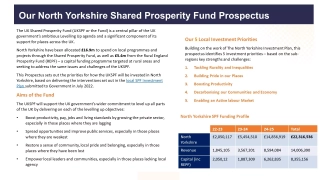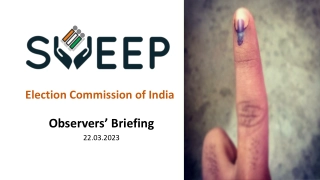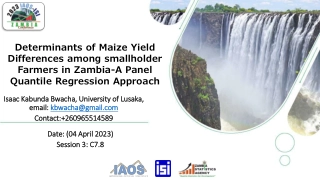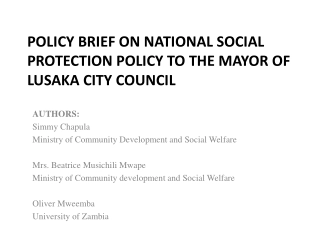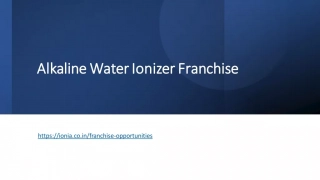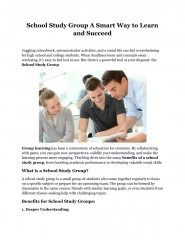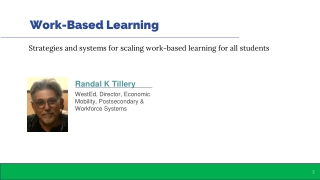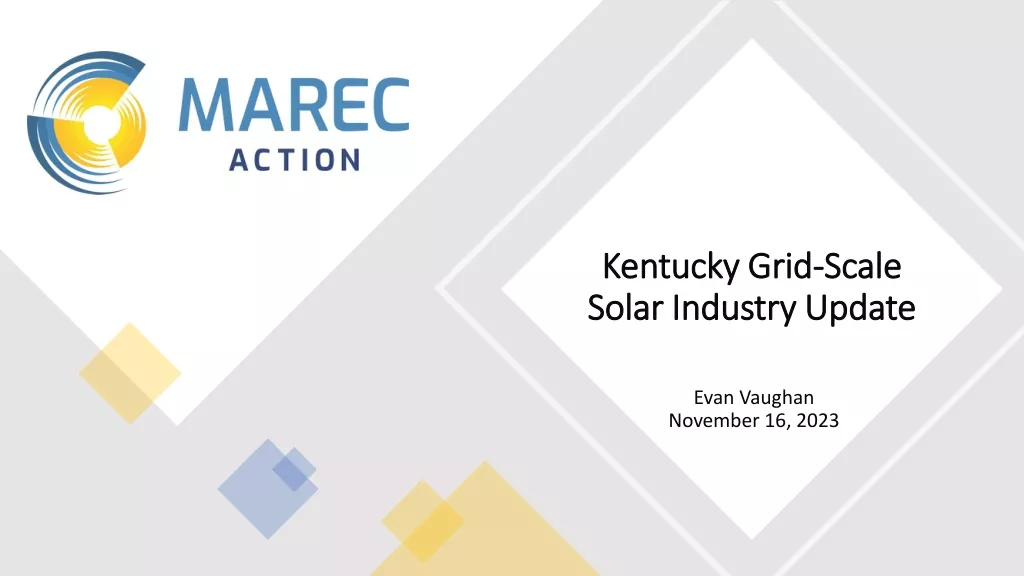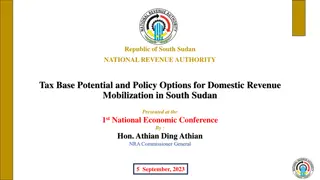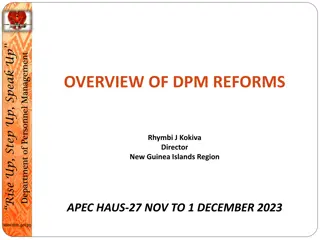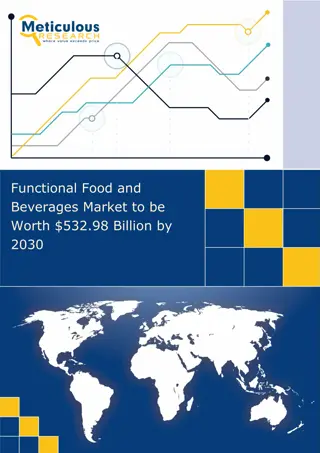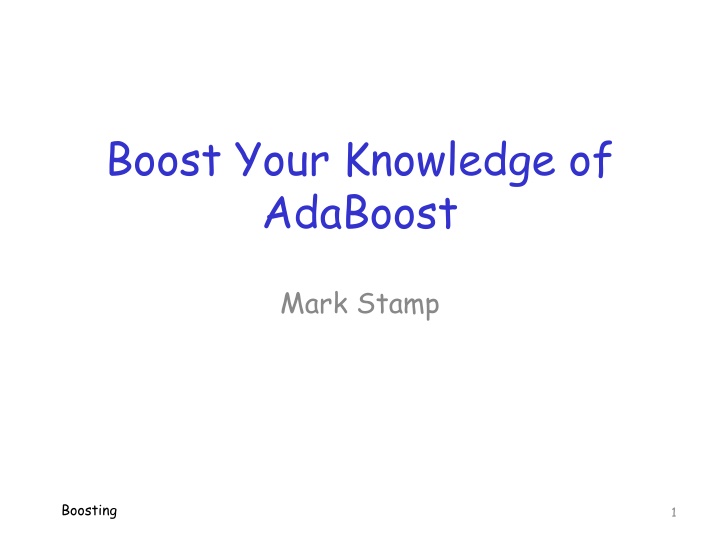
Boost Your Knowledge of AdaBoost: Mark Stamp on Boosting Techniques
Explore the concept of Boosting in AdaBoost as explained by Mark Stamp, focusing on combining weak classifiers to create a stronger meta-classifier. Learn how boosting can enhance performance in various scenarios, including building a football team from mediocre players.
Download Presentation

Please find below an Image/Link to download the presentation.
The content on the website is provided AS IS for your information and personal use only. It may not be sold, licensed, or shared on other websites without obtaining consent from the author. If you encounter any issues during the download, it is possible that the publisher has removed the file from their server.
You are allowed to download the files provided on this website for personal or commercial use, subject to the condition that they are used lawfully. All files are the property of their respective owners.
The content on the website is provided AS IS for your information and personal use only. It may not be sold, licensed, or shared on other websites without obtaining consent from the author.
E N D
Presentation Transcript
Boost Your Knowledge of AdaBoost Mark Stamp Boosting 1
Boosting Suppose that we have a (large) set of binary classifiers o All of which trained on the same problem Goal is to combine these to make one classifier that s as strong as possible We ve seen that SVM (for example) can be used as meta-classifier Boosting is ideal for weak classifiers Boosting 2
Boosting Intuitively, stronger classifiers will yield a better meta-classifier o This is almost certainly true when combining scores using SVM, for example Boosting is somewhat counter-intuitive Boosting produces a strong classifier from many (very) weak classifiers o We ll get an arbitrarily strong classifier, if we have enough (weak) classifiers Boosting 3
Boosting Your Football Team Suppose you are a HS football coach A lot of players tryout for your team, but almost all of them are mediocre o In fact, your best players are only marginally better than playing nobody Can you field a respectable team? What strategy might you use to build a better team from (weak) players? Boosting 4
Choosing Your Team Suppose you simply choose the best player at each position If your best quarterback is terrible o your receivers will never catch a pass o Best receiver might be wasted as receiver o So, it may be better to play your best receiver elsewhere (e.g., defense) o And put someone less talented at receiver Boosting 5
Adaptively Boost Your Team Here is one adaptive strategy/algorithm 1. Select the best player, then decide what position he should play on your team 2. Determine the biggest weakness remaining 3. From unselected players, choose one that can best improve weakness identified in 2 4. Decide exactly what role the newly- selected player will play 5. Goto 2 (until you have a team) Boosting 6
Boosting Your Team Will strategy on previous slide give you the best possible team? o Unlikely, since finding best possible might require an exhaustive search But, boosting strategy could produce a better team o At least as compared to simply selecting the best player at each position o Especially when players are not so good Boosting 7
Adaptive Boosting Boosting is like building good football team from mediocre players At each iteration o Identify biggest weakness o Determine which of available classifiers will help most wrt that weakness o and compute a weight for new classifier Note that this is a greedy approach o Not a hill climb! What s the difference? Boosting 8
AdaBoost Strengths Weak (but nonrandom) classifiers can be combined into strong classifier o Arbitrarily strong! o Cannot do better than arbitrarily strong Many different boosting algorithms We ll only look at one algorithm o AdaBoost (Adaptive Boosting) o AdaBoost easy and efficient to implement Boosting 9
Boosting Weaknesses Very sensitive to noise , including o Mislabeled training data, outliers, etc. The issue with noise should become clear as we discuss the algorithm May need LARGE number of classifiers Resulting classifier may be costly to use So, in practice may not get wonderful results promised by the theory Boosting 10
AdaBoost AdaBoost is a popular and well-known method of boosting AdaBoost is iterative and adaptive o Make selection based on what has been selected so far o This is the sense that it is adaptive And we ll always be greedy o Want biggest boost possible at each step o Biggest boost can make things worse Boosting 11
AdaBoost Assume that we have a labeled training set of the form (Xi,zi), for i = 1,2, ,n o Where Xi is training vector and zi is label o We ll assume labels are +1 and -1 We also have L classifiers (all weak) o Denoted c1, c2, , cL o Each cj assigns a label to each Xi We combine cj to yield a classifier C(Xi) Boosting 12
AdaBoost We construct table where +1 and -1 are classifications provided by ci This is input to AdaBoost algorithm Boosting 13
AdaBoost Iterative process Generate a sequence of classifiers, call them C1(Xi), C2(Xi), , CM(Xi) o Where C(Xi) = CM(Xi) is final classifier Classifier Cm(Xi) is of the form o Cm(Xi) = 1k1(Xi) + 2k2(Xi) + + mkm(Xi) o And Cm(Xi) = Cm-1(Xi) + mkm(Xi) o Each kj is one of the classifiers ci o And i are real-number weights Boosting 14
AdaBoost At iteration j, we need to decide 1. Which unused classifier kj = cito select 2. Weight j assigned to kj In football analogy, at each iteration 1. Select one of the unchosen players 2. Determine best role for that player How to do this so that we get the most improvement (in greedy sense)? Boosting 15
AdaBoost We define exponentialloss function o Loss function is like a score, except that the smaller the loss, the better o In contrast, a bigger score is better Loss (or error) function at step m is We need to determine km and m Boosting 16
AdaBoost Loss function: Write loss as: Where: Rewrite sum as: Boosting 17
AdaBoost We have: We rewrite this as: This simplifies: And hence: o W = W1 + W2is constant this iteration Choose km so that W2 is minimized! Boosting 18
AdaBoost Now, we have selected km What about corresponding weight m ? Recall: We now know km, so we know W1 and W2 Calculus: Set to 0, solve to find: Where rm = W2/W o Note, rm is (weighted) proportion of errors Boosting 19
AdaBoost Summary of mthiteration Select km so that number of errors, or misses (i.e., W2), is minimized o Like choosing next player as the one that does the most good for your team Once km is known, compute W2 and W Computer m as on previous slide o Choosing best role for the new player Boosting 20
Example We have 100 labeled training samples Set of very weak classifiers o Experiment with 250, 500, and 1000 classifiers o Here, each classifier is only marginally better than random (1% or 2%) Boosting 21
Results With 250 classifiers o Best result is 91% accuracy o And uses 160 classifiers Both 500 and 1k classifiers reach 100% accuracy Boosting 22
Application HMM with random restarts vs boosting Train HMMs (N=2), random restarts o Compare average model, best model, and AdaBoost classifier o Boosting based on classifiers from HMMs Five malware families plus benign set o Based on top 30 opcodes Boosting 23
Malware Families Malware families from Malicia dataset Benign set consists of Win32 exes Boosting 24
Opcodes Top 30 opcodes and families Boosting 25
Initial Experiments Based on 1000 trained HMMs o All subsequent experiments also based on 1k HMMs Boosting 26
Morphing Experiments Morphing to test robustness Insert dead code from benign Boosting 27
Cold Start Problem Cold start refers to training when only limited data is available o Like when initially collecting data o Want to train as soon as possible Boosting 28
AdaBoost AdaBoost can be considered a method to reduce dimensionality (in a sense) o Algorithm only selects things that will improve overall classifier o Irrelevant things (classifiers) ignored Recall, we said mislabeled training data is the Achilles heel of boosting o AdaBoost also has problems with outliers due to exponential weighting Boosting 29
Bottom Line Given lots of weak classifiers o Which can be very weak, but not random We can use boosting to construct an arbitrarily strong classifier AdaBoost uses simple greedy approach o Maximize improvement at each step o But, sensitive to noise and outliers XGBoost is most popular boosting algorithm o Improves on the weaknesses of AdaBoost o Winner strategy in many ML competitions Boosting 30
References M. Stamp, Boost your knowledge of AdaBoost, https://www.cs.sjsu.edu/~stamp/RUA /ada.pdf R. Rojas, AdaBoost and the Super Bowl of classifiers, http://www.inf.fu- berlin.de/inst/ag-ki/adaboost4.pdf Boosting 31
Competitive Equity and AdaBoost Boosting 32
California High School Sports California Interscholastic Federation (CIF) administers high school sports Under the CIF, there are 10 sections o Each section has its own tournaments o Usually, also a CIF state tournament Multiple divisions, usually 1 thru 5 o Division 1 is highest, while 5 is lowest Sometimes an open division at the top Boosting 33
Assigning Schools to Divisions How are schools assigned to divisions? Traditionally, the assignment made primarily based on enrollment o Smallest schools in Division 5 o Biggest schools in Division 1 Most states base such divisions primarily on high school enrollment o Private schools may be handled differently Boosting 34
Aside on Private Schools As of 2016, 25% of schools in U.S. were private (elementary & secondary) Account for about 10% of students o About 22% of private school students were in nonsectarian schools o About 39% of private schools students were in Catholic schools o Most of the remaining 39% were is schools with other religious affiliations Boosting 35
Enrollment and Competition Why base divisions on enrollment? Common sense dictates that more students implies better teams And experience tends to support this Small schools generally could not hope to compete against large schools Boosting 36
Competitive Equity California has to be different o Of course! Instead of enrollment, California uses competitive equity (CE) in tournaments Competitive equity: For tournaments, first select the best teams overall o Then teams assigned to divisions so that divisions are as competitive as possible Boosting 37
Competitive Equity Example Consider football in Central Coast Section (CCS) After the regular season o Select 40 best teams, ranked 1 thru 40 o Seed 1 thru 8 in Division 1, seed 9 thru 16 in Division 2, and so on Advantages? Disadvantages? Boosting 38
Competitive Equity in Football Consider 2019 CCS football playoffs Enrollments ranged from 615 to 3100 o Milpitas HS (enrollment 3100) with record of 4-6, seeded 1st in Division 4 o Bellarmine Prep (record 3-7, with 1625 students) lost to Sacred Heart Prep (7-3 with 615 students) in 1st round of D2 o Sacred Heart then lost to Los Gatos HS (2100 students, 9-1 record) Boosting 39
Girls Volleyball Example 2019 CCS Girls Volleyball Tournament LGHS seeded 1st of 13 teams in D1 o Also, a higher open division in volleyball LGHS competed against similar sized schools, losing in finals to Gunn HS After losing, LGHS seeded 1st in NorCal D2 bracket of CIF tournament Boosting 40
Girls Volleyball LGHS won NorCal bracket of CIF tournament, losing 1 set in 4 matches LGHS wins were vs following schools o Christian Brothers of Sacramento (1166) o James Logan HS of Union City CA (3600) o Lincoln HS of Lincoln CA (1832) o Central Catholic of Modesto (379) Boosting 41
Girls Volleyball Continued 2019 CIF D2 championship o Winner of NorCal tournament vs winner of SoCal tournament LGHS won NorCal, Ontario Christian HS won SoCal LGHS lost CIF finals (straight sets) Enrollment of Ontario Christian HS is about 400 vs 2100 for LGHS Boosting 42
Enrollment and CE These examples show that big schools sometimes lose to much smaller schools o Although small privateschools Competitive equity likely ensures many more evenly-matched tournament games But, is competitive equity fair ? Don t large schools have an inherent advantage? Boosting 43
CE and AdaBoost Recall that in AdaBoost, more classifiers gives better results o Even when only selecting a subset of them In terms of CE, this means that larger schools have an inherent advantage! o More players to choose from Large school winning a lower division tournament has not accomplished much Boosting 44
AdaBoost and Classifiers At every stage, more classifiers is an advantage Advantage grows the larger the team size? Boosting 45
AdaBoost and CE Issues For this AdaBoost example, not clear how classifiers relates to players And what if a team has good players? o Graph on previous page assumes uniformly mediocre players Private schools might have some top players, or better players on average Interesting numerical experiments... Boosting 46
More Generally... Can we learn something about human learningfrom machine learning ? Maybe models are not just useful for classification and generation o Perhaps we can learn from machine learning For example, consider backpropagation o What does this say about human learning? Generative models and creativity? Boosting 47
Summary Perhaps ML/DL/AI can be useful in a completely different way! Not just for classification/generation What can we learn about learning? o This seems to be an unexplored area Seems to me that there are some interesting research problems here o A bit challenging to define/analyze Boosting 48

